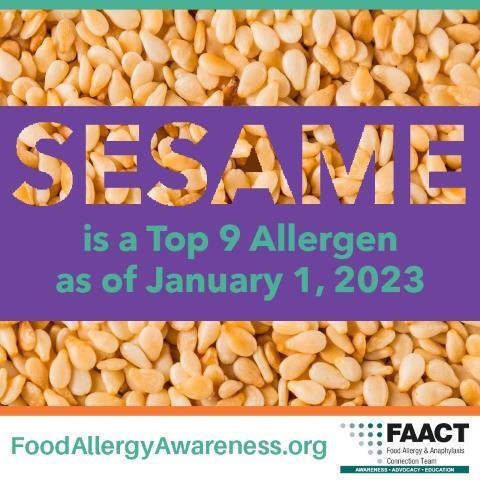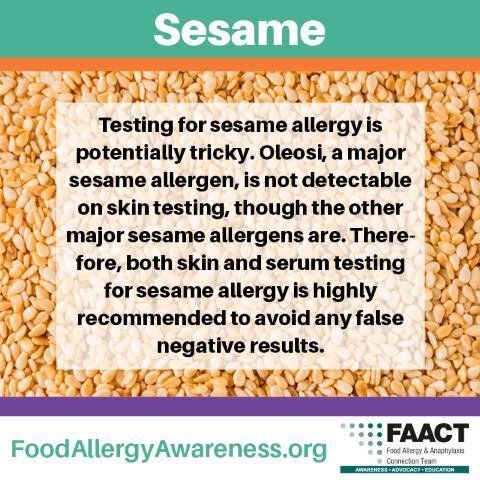Sesame
Subcategories

Sesame
Sesame is the ninth major allergen effective January 1, 2023 and must be labeled in plain language on packaged foods in the U.S. Foods containing sesame will be subject to specific food allergen regulatory requirements, including labeling and manufacturing requirements.
We remind consumers that foods already in interstate commerce before 2023, including those on retail shelves, do not need to be removed from the marketplace or relabeled to declare sesame as an allergen. So depending on shelf life, some food products may not have allergen labeling for sesame on the effective date.
- Previously safe products might have new sesame warnings; therefore, it is critical to read ALL labels as this transition takes place.
- Consumers should check with the manufacturer if they are not sure whether a food product contains sesame.
Under the FASTER Act of 2021, sesame is recognized as the 9th major food allergen effective January 1, 2023. Manufacturers must list it as an allergen, although in most cases it must appear in the ingredient statement.
Sesame allergy is a rising problem in the US and is now considered one of the top 9 allergens effective January 1, 2023. Approximately 0.23% of US children and adults are allergic to sesame(1). Other seeds that are known to cause allergy include pine nut, macadamia nut, flaxseed, sunflower seed, buckwheat, and mustard. Rates of sesame allergy may differ based on cultural dietary preferences. India, despite high intake of sesame, has low rates of allergy, though in other cultures such as Israel, sesame allergy is more common than peanut allergy.
Sesame consists of several major allergen classes, including seed storage proteins, vicilins, and oleosin. Testing for sesame allergy is potentially tricky. Oleosi, a major sesame allergen, is not detectable on skin testing, though the other major sesame allergens are. Therefore, both skin and serum testing for sesame allergy is highly recommended to avoid any false negative results. There may be differing amounts of allergens contained among the 3 varieties of sesame seeds. White sesame seeds contain the most allergen compared to brown or black seeds. However, all seeds are allergenic. Sesame oil is considered highly allergenic, as is sesame flour.
Individuals with a potential sesame allergy diagnosis should seek a board-certified allergist recommendation for confirmation. Testing should include both skin and blood testing because oleosins are poorly detectable by skin testing. Because sesame is a seed and has evolved from a plant, there are common proteins shared between other seeds, peanut, tree nut, and certain plants (in particular plants used for spices). Common proteins are even noted with carrot and kiwi. As is the case with peanut and tree nut, on allergy tests, the common proteins and similar structures may be responsible for high rates of co-positive tests when assessing for cross-reactivity. Please keep in mind that just having a positive allergy test does not automatically mean that the person is allergic to the item, especially if the person has never eaten the item and developed symptoms. Most of the cross-reactivity has little clinical significance, but always check with your allergist first. In some situations, a food challenge to the item in question may be recommended to determine if these items are safe to eat. However, in others, in particular the cross-reactive item was commonly eaten before the sesame allergy was diagnosed, a challenge is probably not necessary. However, some allergists do recommend total avoidance of potentially cross-reactive foods such as other seeds, peanut and/or tree nuts. The risk of sesame co-processing of these items is not well-described. Please check with your allergist for your specific management plan.
From Mary H. Weiser Food Allergy Center:
In the latest Mary H. Weiser Food Allergy Center video webinar, moderator Kim Menzel, LMSW, a food-allergy informed social worker, is joined by Steven M. Gendel, PhD, who has more than 30 years of experience working to protect food safety and public health. Together, they discuss the FASTER Act provisions and other food labeling information for individuals and families coping with food allergy.
Dr. Gendel spent more than two decades developing science and policy in the FDA Center for Food Safety and Applied Nutrition. He was the first FDA Food Allergen Coordinator and contributed to the creation of agency policy, guidance documents, and regulations. He is an internationally recognized expert on food allergen management and on safety assessments for new food proteins. Currently, Dr. Gendel is an independent consultant at Gendel Food Safety LLC.
The FASTER Act and food labeling: What food allergy families need to know (YouTube)
Common Sources of Sesame
- Hamburger buns
- Pizza crust
- Wafers
- Breads (breadsticks, rolls, bagels)
- Pastries
- Pretzels
- Crackers
- Biscuits
- Cookies
- Candies
- Noodles
- Soups
- Energy bars
- Ice cream
NOTE: Please keep in mind in a culturally diverse world, different ingredients may be used in different recipes. Always use extreme caution.
- Salad dressing
- Oils
- Hummus
- Flafel
- Tahini
- Simit (Turkish pretzels)
- Margarine
- Pharmaceutical products (check package insert)
- Nutritional supplements
- Medications
- Cosmetics (found in many lip balms, ointments, soaps, oils, creams, eye products)
Practical Tips
It is recommended to always carry at least two (2) epinephrine devices at all times if you have been diagnosed with a sesame allergy. This is in case one dose doesn't work or if symptoms return and a second dose is needed. If an epinephrine device has been used, always seek emergency medical assistance immediately. This is due to the possibility of a biphasic reaction. A biphasic reaction is when a second wave of a reaction occurs, which is usually stronger than the first. It can occur within 2-4 hours and in some cases, up to 8 hours, after the initial reaction. Stay in medical care for at least 4-6 hours. Strict avoidance of sesame and products containing sesame is necessary.
Read all product labels prior to the consumption of a new food product. Before consuming any products, it is important to always read labels carefully to ensure the safety of a food product. In the United States, sesame is required to be labeled per FALCPA. In some circumstances, if sesame is used as a flavoring agent and not a primary ingredient, sesame can be referred to as “spice” or “spices”.
Cross-contact from cooking utensils or products like using the same knife or spoon that was used for spreading hummus or eating lettuce from a salad bar right next to a dish of sesame seeds used as a condiment. Both pose a potential danger. The knife that was used is no longer safe for the sesame allergic individual. A new, clean knife should be used. As well, the salad bar represents a possible contaminated surface or cross-contaminated food. Lettuce and other salad items that are stored apart from the sesame should be used. Another example is scraping off sesame seeds from a meal and serving it to a sesame-allergic individual. It is still unsafe for consumption. A new clean plate, with a safe meal, should be served to the sesame-allergic individual.
Other pages that may be of interest:
Visit FAACT's “CROSS-CONTACT” page to review how to properly clean allergens from hands and surfaces.
Reference
(1) Prevalence and Severity of Sesame Allergy in the United States

FAACT
Did you know that sesame is one of the few allergens that requires testing both with skin and blood tests to detect all relevant allergens? Oleosin can be missed if just skin testing is used, as it is not well-detected through commercial skin testing extract, but is by standard serum IgE testing.

